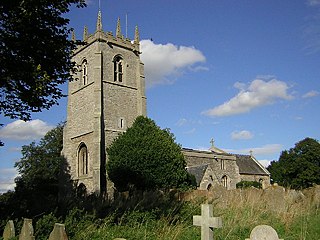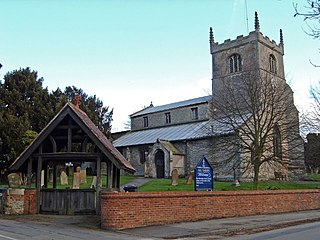
The Trent is third in the list of longest rivers in the United Kingdom. Its source is in Staffordshire, on the southern edge of Biddulph Moor. It flows through and drains the North Midlands into the Humber Estuary. The river is known for dramatic flooding after storms and spring snowmelt, which in the past often caused the river to change course.

Collingham is a village and civil parish in Nottinghamshire, England. The population at the 2011 Census was 2,738.

Newark was a wapentake of the historic county of Nottinghamshire, England.

Farndon is a small village and civil parish in Newark and Sherwood district of Nottinghamshire, England. It is on the historic Fosse road and is 3 miles (4 km) south-west of Newark-on-Trent. It is on the banks of the River Trent. The population of the civil parish as of the 2011 census was 2,405. The A46 previously ran through the village until the development of a new dual carriageway bypass.

Norwell is a village and parish about 6 miles (9.7 km) from Newark-on-Trent, in central Nottinghamshire, England. The population at the 2011 census was 490. It is close to the border with Lincolnshire and the River Trent, and lies approximately 1.5 miles (2.4 km) from the A1 road and 1 mile (1.6 km) from the East Coast Main Line.

Sutton-on-Trent is a large village and parish in Nottinghamshire, situated on the Great North Road, and on the west bank of the River Trent.

Langford is a village and civil parish in Nottinghamshire, England. It is located four miles north-east of Newark-on-Trent and two miles East from The River Trent. Population details are included in the civil parish of Holme. It is based on A1133 which comes off of the A46. Although Langford is currently located two miles from The River Trent it has not always been this way. In "1575 there was a cataclysmic flood" which altered the course of the Trent which meant Langford and Holme were now on the same side of the river. Before this change in the rivers course the Trent used to flow next to St Bartholomew's church and Holme was on the opposite side of the bank.

Coddington is an English village and civil parish in Nottinghamshire, 3 miles (4.8 km) east of Newark-on-Trent. According to the 2001 census it had a population of 972, which increased to 1,684 at the 2011 Census and to 1,701 at the 2021 Census.

St Bartholomew's Church, Langford is a Grade I listed parish church in the Church of England in Langford, Nottinghamshire.

St Giles' Church, Holme is a Grade I listed parish church in the Church of England in Holme, Nottinghamshire.

St Cecilia's Church, Girton is a Grade II listed parish church in the Church of England in Girton, Nottinghamshire.

All Saints' Church, Harby is a Grade II listed parish church in the Church of England in Harby, Nottinghamshire.

St George the Martyr's Church, North and South Clifton is a Grade II* listed parish church in the Church of England in North Clifton, Nottinghamshire.

All Saints' Church, Collingham is a Grade I listed parish church in the Church of England in Collingham, Nottinghamshire.

St John the Baptist's Church, Collingham is a Grade I listed parish church of the Church of England in the village of Collingham, Nottinghamshire.

Holy Trinity Church, Besthorpe is a Grade II listed parish church in the Church of England in Besthorpe, Nottinghamshire.

St Helen's Church is a Grade II* listed parish church in the Church of England in Thorney, Nottinghamshire.

All Saints' Church, Winthorpe is a Grade II listed parish church in the Church of England in Winthorpe, Nottinghamshire, England. The current building, the construction of which was completed in 1888, is at least the third version of the church, which dates back to at least the early 13th century. All Saints' Church was commissioned by the church rector, Edward Handley, in memory of one of his relatives.




















